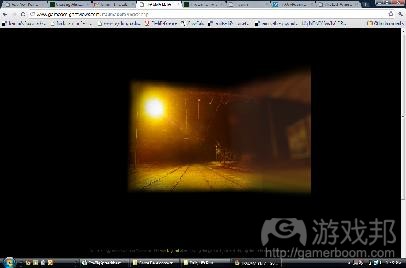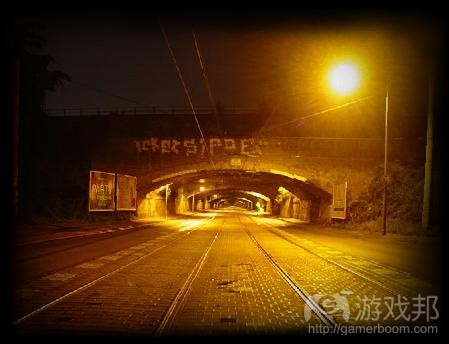3项设计助《Trauma》营造现实主义气氛
作者:Brice Morrison
《Trauma》获2010 Independent Game Festival两项提名,我个人对这款游戏期盼已久。游戏讲述的是一个妇女从车祸中幸存后发生的故事,玩家在游戏中经历了她的梦想、回忆和对生活的思考。如果能获得游戏测试邀请,绝对是件很幸运的事情。我可以告诉你,游戏不仅具有娱乐性,而且会激发你的思维,吸引你在其中投入时间。
《Trauma》的制作者Krystian Majewski在许多方面都做得很好,但是我认为他特别擅长于营造气氛,从游戏受最佳视觉效果奖和最佳音效奖提名便可见一斑。当你在玩《Trauma》的时候,你会感觉到自己不是仅仅在玩游戏。你所在的房间消失了,你忘却了自己正做在椅子上,你进入了游戏主角的梦中。探索,移动,观察,思考,产生孤独感。
这确实是种令人困惑的体验。
《Trauma》是如何实现这种效果的呢?制作者采用了多种技术来实现这种效果,包括游戏的美学布局、视角和音效,有些位于游戏内,有些甚至位于游戏之外。现在,让我们来看下制作者采用的方法。
选取现实生活中的图片让游戏更为逼真
《Trauma》由现实世界中的图片组成。玩家可以在图片质量极高的幽暗小径、宁静的街道拐角和洒满月光的公园中探索。此外,图片采用3D式界面导航,这在Flash游戏中算较为先进的做法(游戏邦注:效果同微软的Photosynth类似)。
因而,导航很重要。四处观察,转向,靠近继续查看。你感觉自己正处在真实的空间中。为什么呢?因为游戏采用的并不是卡通或矢量图像。所有的图像都来源于真实生活中,现实性突出。使用真实的图像并对其进行编辑,添加游戏玩法道具,Krystian成功地将现实世界中的日常领域带到游戏中,营造出游戏所需的现实气氛。
这让我回想起早期的《生化危机》之类的游戏。在这些游戏所处的年代里,没有类似的技术来营造照相现实主义。但是游戏的挑战确实唤起了玩家心中的恐惧感,让玩家感觉游戏是真实的。人类不会对卡通的东西感到恐惧,他们只害怕真实的事物。
那么,当时Capcom的制作团队是如何实现的呢?他们使用一系列静态图片,在上面运行3D角色。这使得游戏的场景更具现实性,通过这种气氛来引发游戏所需的恐怖感。
制作者利用来自现实生活的图片,并将导航设置其中,这样《Trauma》的玩家就无需强制在脑中想象游戏事件是真实的。或许我在德国的大街小巷中行走时,会看到游戏中的场景。
实现照片现实主义的方法不止一种。如果游戏想要营造出现实生活的感觉,而且制作者没有足够的资源采用高端3D技术,那么有时在游戏中使用来源于现实生活的静态图片也是种可取之法。
消除玩家的分心
《Trauma》第二项营造气氛的技术乍看之下似乎并不那么有效,但是我认为这是提升游戏体验的关键所在。当你加载游戏时,页面大部分是黑色背景。
这是最为简单的设计。页面上除了这个神秘的亮着路灯的街道拐角外,一无所有。这对气氛的营造有着显著的效果。
接下来,我将花点时间来解释下这种设计的必要性。《Trauma》创造出的是极为吸引人的游戏情景,玩家会被故事所吸引,游戏中突然出现的音效和光照会让你产生恐惧感,就像好莱坞的电影一样。这款游戏不是几分钟的时间就可以体验完的。但是好莱坞电影有一定的优势,因为你在看电影的时候正处在有着巨大屏幕和环绕音效的黑暗屋子中。即便是主机或可下载PC游戏,它们在气氛营造上也同样拥有优势,因为游戏可以全屏显示。
但是《Trauma》呢?《Trauma》是款Flash游戏。对Flash游戏来说,营造气氛是件很困难的事情。为表明我的观点,在此将上面《Trauma》的截屏同网络上其他Flash游戏的截屏相对比:
通过这样的对比,我们会注意到什么呢?
人类会将注意力放在环境中移动的事物上。我们的眼球会移向那些正在移动、做出动画或发生改变的物体上。因而,《Trauma》为了让你感受到此刻只有游戏中的梦境正在运转,于是就需要让所有其他东西停止下来。
不要对我产生误解。我赞成Newgrounds这类网站发布广告,推荐其他游戏以及对其发表评论。这对他们的业务运营有利,而且能够创造出优秀的整体网站体验。但是,游戏体验因此而受到影响,玩家受到了影响。那么,这会产生什么后果呢?Newgrounds和Kongregate等站点上流行的将更多是那些无需玩家思考,快速做出点击动作的游戏。因为,这些是你在分心时依然能够玩下去的游戏。
而在体验《Trauma》时,你需要投入100%的注意力。因而,如果要让Flash游戏产生吸引人的体验,而不出现玩家打开游戏点击几下鼠标就离开的情况,那么开发商可以尝试为游戏设置空无一物的黑色背景,这样就能够消除玩家的分心。
出色的音效
最后,《Trauma》有着令人印象深刻的音频设计。通常情况下,当我提及游戏拥有令人印象深刻的音频时,我指的是游戏中的旋律、电子吉他或某些管弦乐很出众。
但《Trauma》的情况有所不同。其音频的存在完全是为了营造气氛。这个神秘世界有着低沉的音效,你几乎无法察觉到它的存在。我认为,这是最适合《Trauma》游戏体验的音乐。虽然《超级马里奥银河》等游戏的旋律和曲调的确很出色,但是它们与现实生活格格不入。它们适合使用这样的音乐,因为它们的目标就是卡通化,或者让玩家意识到他们就是在玩游戏。
但是对《Trauma》来说,从设计角度上来看,使用与它们相同的音乐便是致命的错误。因为游戏的神秘性以现实性为基础,所以需要以低音音乐来营造气氛,吸引玩家沉浸其中。
显然,对于那些更注重现实生活般体验的游戏来说,开发商应当考虑使用与现实生活场景类似的环绕音乐,比如低沉的管弦乐、脚步声或汽车发动机的轰鸣声。
总之,《Trauma》给玩家带来梦境般的体验,而这个梦境显得格外真实。游戏世界是真实的,低沉的音效帮助你感受周围的气氛,而这正是制作者所要取得的目标。(本文为游戏邦/gamerboom.com编译,拒绝任何不保留版权的转载,如需转载请联系:游戏邦)
How Trauma Evokes a Realistic Atmosphere
Brice Morrison
Trauma, a game that was a two-category finalist in the 2010 Independent Game Festival, is a title that I personally have been looking forward to for a long time. Following the story of a woman who survives a car accident, the title takes the player through a series of her dreams, echoing moments and thoughts of her life (or are they?) Yours truly was lucky enough to get a Beta invitation, and I can tell you, the game is not only entertaining, it’s also intellectually stimulating and very engrossing.
Krystian Majewski, Trauma’s creator, does many things well, but what I believe it excels most at, as evidenced by its nominations for Excellence in Visual Art and Excellence in Audio awards, is creating an atmosphere. When you’re playing Trauma, you aren’t just playing a game; the room you’re in falls away, you forget about the chair you’re sitting on, and you enter into the woman’s dream. Exploring, moving, looking, thinking, and feeling very alone.
It truly is a mystifying experience.
How is Trauma able to do this? There are a couple of techniques that it employs to get the job done, all within the game’s Aesthetic Layout, the sights and sounds, some inside and some even outside the game itself. Let’s take a look.
Want to Look Real? Take Images from Real Life
Trauma is made up of clicking on images that are taken from the real world. Very high quality and wonderful shots of dark alleys, lonely street corners, and moonlit parks allow for exploration. Additionally, the images are navigated through a 3D style interface which is very advanced for Flash (it looks very similar to Microsoft’s Photosynth, if it doesn’t use it directly).
Thus, navigation is a snap. Look around, turn, look closer. You feel like you’re in a real space. Why? Because it’s not a cartoon, or some vector graphics, or anything else. All the images are actually taken from real life and have a photorealistic level of detail. By stitching together these spaces using real images and then editing them as he saw fit to add gameplay items, Krystian was able to turn an everyday real world area into a game space and create the atmosphere the game needed.
In a way this reminds me a lot of the early Resident Evil games. At the time of these games, they didn’t have anywhere near the technology to make for photorealism. But their challenge to evoke fear in players demanded that the player feel like the game was real. People don’t get scared of cartoons. They typically only get scared of live action films.
So what did the Capcom team do? They used a series of still images with 3D characters running on top. What this allowed them to do was to render scenes much more realistic than otherwise possible, and evoke the terror they needed through the atmosphere.
By taking images from real life, and navigating around them, players of Trauma don’t need to make much of a mental leap for it to feel like it could actually happen, or actually exist. I wouldn’t be surprised if I was walking around in Germany and came upon one of the scenes from the game. Try getting that feeling with Canabalt.
There is more than one way to reach photorealism. If a game is seeking to feel like real life, and there aren’t the resources to pull off high-end 3D, incorporating still images from real life can sometimes do the trick.
Eliminating Distractions
The second aspect of Trauma that contributes to atmosphere may at first not seem like that much of a big deal, but I believe it is key to the experience. When you load up the game, the page that it’s on is entirely black.
Complete solitude and simplicity. Nothing is going on except this mysteriously lit street corner. Definitely conducive to atmosphere.
Take a moment to appreciate how necessary this is. Trauma has created a captivating scene, one that pulls you into the story, has you jumping with fear at sudden sounds and lights, just as any Hollywood movie would. It’s not a game that can be played in a couple of minutes. But Hollywood movies have the benefit of trapping you in a dark room with a giant screen and surround sound. Even console or downloadable PC games have a similar advantage – they take up the whole screen.
But Trauma? Trauma is a Flash game. Creating an atmosphere is difficult for Flash games. To illustrate my point, contrast the above Trauma screenshot with your average flash game anywhere else on the web:
What are we supposed to pay attention to again?
Humans are programmed to notice movement in their environment. Our eyes move to objects that are moving, animating, or changing. Thus, in order for Trauma to make you feel like there is nothing else in your life going on at the moment other than this dream, everything else needed to be blocked out.
Now, don’t get me wrong. I’m all for sites like Newgrounds putting ads, suggested other games, and reviews around their games. It keeps them in business and creates a great overall site experience. But it also detracts from the game experience, distracting the player. What is the consequence of this? Games that are going to be popular on sites like Newgrounds or Kongregate are going to be more of the fast-twitch, no thought, action click games. Because those are the games that you can play while distracted.
With Trauma, you need to be sucked in, 100%. So for Flash Game titles that want to evoke a more engrossing experience instead of the usual click-and-gone, developers could try giving the game its own page with a blank, black background to cut out the visual noise normally associated with Flash titles.
There’s No Music In Real Life
Finally, Trauma has an incredible soundtrack. Usually when I think of incredible sound tracks for games, I imagine humming a tune, a favorite melody, some great electric guitar or some great orchestrated music.
Not Trauma. Its soundtrack is all about ambience. Sounds of a mysterious world, low, hushed tones that you barely know are there. I believe this is the best possible kind of music that Trauma could have had for the experience it was seeking to evoke. While the melodies and tunes in other games like Super Mario Galaxy are fantastic, they don’t make it feel like real life. And that’s fine for them, because they are attempting to feel like a cartoon, like an epic movie, or make the player acutely aware that they are literally playing a game.
But for Trauma that mistake could have been fatal from a design perspective. Since the game’s mystery thrives on realism, the low bass tones and squeaks from the soundtrack are just enough to keep you on an uneasy edge, but not enough for you to consciously wake up to it. Not unlike the noises of a hospital room.
The lesson is clear: For games that try to feel less like an epic feature film and more like an actual real life experience, developers should consider using ambient music that mimics the sounds vacuum of real life. Low strings, foot traffic, or car horns are all sounds of real life.
All in all, Trauma delivers a great experience of feeling like you are in a dream, and beyond that, a real dream that you could actually have. The world looks real, the dark tones put you on edge, and something just…doesn’t feel right. And that is exactly spot on. (Source: The Game Prodigy)











































 闽公网安备35020302001549号
闽公网安备35020302001549号